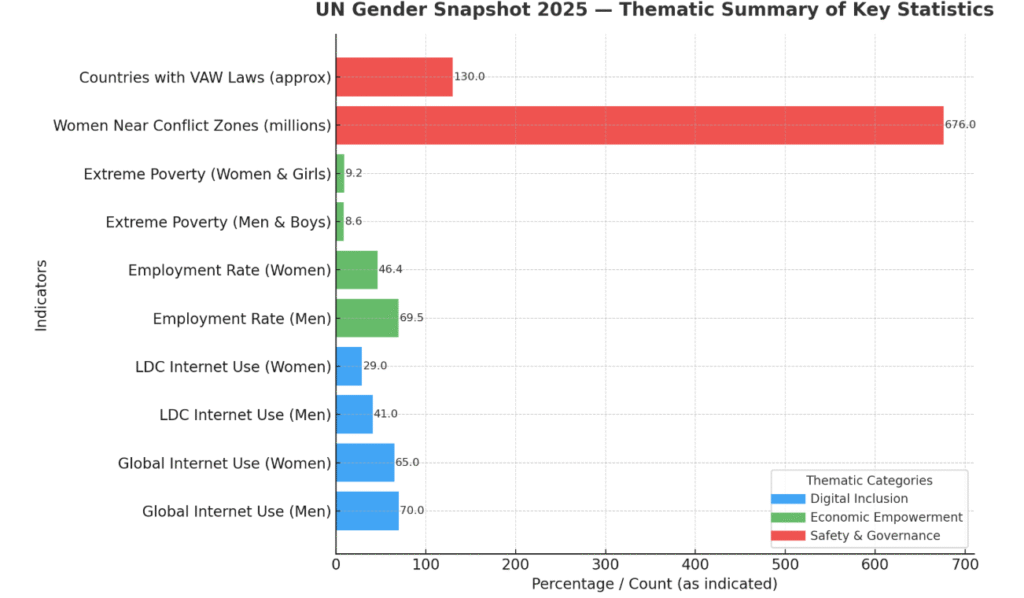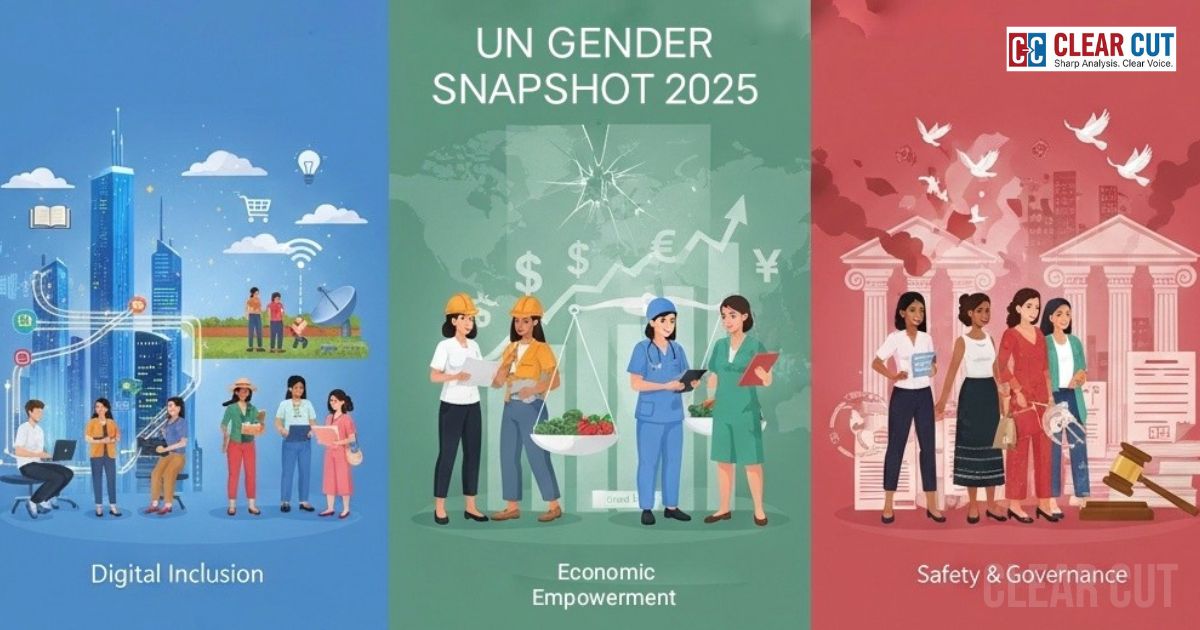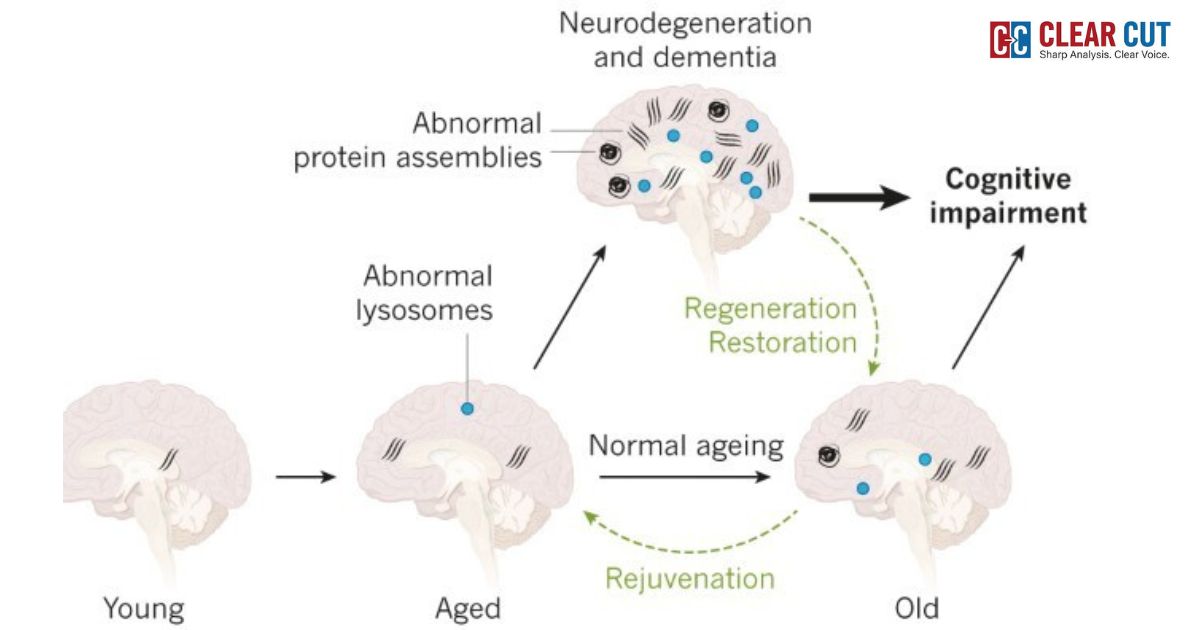Photo Credit: Antara Mrinal
Clear Cut Gender Desk
New Delhi, UPDATED: Oct 08, 2025 09:45 IST
Written By: Antara Mrinal
The Gender Snapshot 2025 feels less like a lookback and more like a moment of reckoning: as we head into the final five years before the 2030 deadline to achieve the Sustainable Development Goals (SDGs), the report cautions that, if present trends continue, the world will close out 2030 with 351 million women and girls still in extreme poverty. This figure is not framed as a fate, but a choice – a consequence of stalled financing, decreasing budgets for statistics and services, ongoing conflict, and a global backlash that has erased previous progress. The Snapshot draws on data from all 17 of the SDGs to show where countries are experiencing a slowdown in progress, where regression is occurring, and where targeted investments could have tremendous payoffs (UNSD).
Digital Exclusion: a $1.5 trillion opportunity missed
One of the most pronounced and actionable findings in the Snapshot is the gender digital divide. Worldwide in 2024, men (70 percent) were online more than women (65 percent) – a difference that was larger in least developed countries where fewer than 29 percent of women were online compared to 41 percent of men. The report provides the returns – closing the gender digital divide could directly unlock approximately 343.5 million women and girls globally, reduce estimated economic losses of USD 1.0 trillion annually and raise an estimated 30 million people out of extreme poverty before 2050, as well as add a possible total of USD 1.5 trillion to global GDP before 2030 (with much larger cumulative benefits before 2050). Simply put, women who will be able to benefit from digital access have the potential for measurable economic and social returns, which will require investments in infrastructure, gender-sensitive digital literacy and to support their opportunities in the labour market (UNSD).
Work and poverty: entrenched gaps undermining growth
The Snapshot highlights the continuing disparities by gender in labour force participation and social protection, which keep many women in poverty. In 2024, the employment rate of women of working age was 46.4 percent compared to 69.5 percent for men, a gap of 23.1 percentage points. This means women work at an employment rate that is approximately two-thirds (about 66.8 percent) of men’s rate, reflecting labour market barriers to decent work, over-representation in informal and low-paid work, and unequal care responsibilities. The Snapshot indicates that in 2025, 9.2 percent of women and girls live in extreme poverty, compared to 8.6 percent of men and boys, and 2 billion women and girls are still without any social protection. These figures aren’t abstract numbers, they note massive groups of women being excluded from the formal economy, and, indeed, from the social safety nets that should soften shocks (UNSD).
Violence, conflict and insecurity: Progress under pressure
On the protection front, the Snapshot documents both the progress within laws and the worrying persistence of violence. Having national action plans, and even laws specific to violence against women and girls, are great strides made in many countries, from data available from today to some countries actually facing the realities of not making progress. A women’s daily lived experience remains stark: globally, more than one in eight women (15-49 age group) have experienced physical and/or sexual violence by a current or former intimate partner in the past year (around 12.5%). Conflict exacerbates vulnerabilities: estimates indicate that in 2024, 676 million women and girls were living within 50 km of have faced a lethal conflict event – the highest figures recorded since the 1990s – as conflicts and humanitarian crises are significant contributors to a stall of progress in gender equality (UNSD).

The chart represents the main gender gaps highlighted in the UN Gender Snapshot 2025. While there has been global progress, distinct gaps remain across digital, economic, and safety spaces. Specifically, there is still a global gender gap in digital inclusion (70% men with internet access, 65% women globally) and the gap widens even more significantly in least developed countries (41% men with internet access, 29% women). In terms of economic participation, women’s employment rate is still considerably lower (46.4%) than men’s (69.5%), and a higher share of women and girls (9.2%) continue to live in extreme poverty than men and boys (8.6%). In terms of safety, approximately 676 million women live in conflict-affected areas and approximately 130 countries have passed laws against violence against women. Overall, the graph illustrates the way digital exclusion, economic inequality, and insecurity intersect to slow progress globally in gender, highlighting the urgent need for investments and policy action before 2030.
Data and budgets: an invisible but decisive crisis
A notable and underreported finding is that the data systems and funding that governments and civil society rely on to create gender responsive policy are in jeopardy themselves. The Snapshot provides new estimates that suggested improved availability for SDG 5 indicators at 57.4% for 2025 (up from 47.0% in 2022), but nearly seven in ten national statistics offices indicated decreased funding since January 2025 (68.3% overall; 51% for Demographic and Health Surveys). With reduced statistical capacity the risk is blinding ourselves to where problems are getting worse and what is working where, and again the Snapshot warns that cuts to data will yield worse decisions just when focused investments are needed desperately (UNSD).
Where targeted investments yield results
Despite the alarming headlines, the Snapshot is not determinative – it provides intervened and costed scenarios that demonstrate what can be done. Under an “Accelerated SDG push” scenario, a suite of measures could lift 52 million women and girls out of extreme poverty by 2030 and 110 million by 2050; modelled targeted digital inclusion investments could enhance food security and incomes for millions in a similar way. The Beijing +30 Action Agenda within the report stresses six key areas of focus, including two with clear investment pathways (digital inclusion and freedom from poverty) and argues that modest policy shifts and public investment targeted strategically could change the course from now and into 2030. These pathways catapult the report from merely cataloguing risk and loss to presenting a menu of possible choices (UNSD).
The political choice to make
If there is one through line in the Gender Snapshot 2025, it is this – most outcomes will depend on political will. How different the “business as usual” 2030 is from a more equitable 2030, will be measured in millions of lives and trillions of dollars. In the Snapshot we put numbers on both the human toll and the economic benefit – 351 million women and girls in extreme poverty should current trends continue; tens of million fewer in extreme poverty should we act with speed; a $1.5 trillion GDP boost by closing the digital divide by 2030; and tens of millions receiving access to social protections and safety from violence through targeted public investment. As such, the report functions as both a call to urgency and a call to action: invest in gender data, protect and expand social protection, close the digital divide, and fund programmes that reduce unpaid care work. The choice is clear and time is of the essence.
With inputs from:
- UN Women & UN Department of Economic and Social Affairs (UN DESA), 2025. Progress on the Sustainable Development Goals: The Gender Snapshot 2025.
- UN Women Data Hub, 2025. Gender Snapshot 2025 Highlights – Global and Regional SDG Gender Indicator Data.
- United Nations Statistics Division (UNSD), 2025. SDG Indicator Database: Gender Equality (Goal 5).
- UN Women (2024–2025). Beijing+30 Action Agenda and Digital Inclusion Briefs.
- World Bank Gender Data Portal, 2024. Labour Force Participation and Social Protection Data by Sex.




